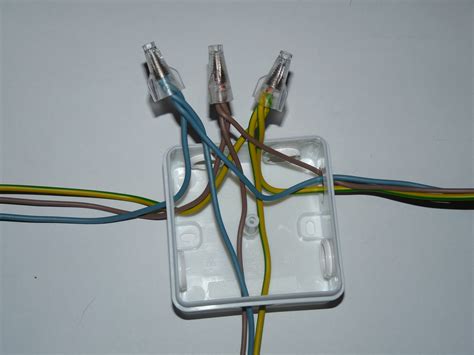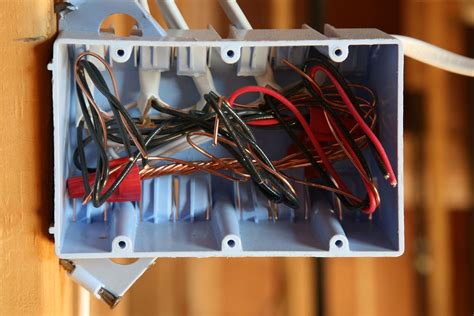boxing in electrical wires You'll learn all of the pro techniques for a wiring job, including choosing the right size receptacle boxes, running cable throughout the room, and making the electrical connections. Plastic boxes and flexible nonmetallic cable .
Columbia Cooling & Refrigeration includes the only sheet metal fabrication shop in town. We handle work in-house and on-site, providing customized filter boxes, vents, ductwork, and everything necessary to optimize airflow, energy efficiency, air quality and space savings.
0 · wire nuts for electrical box
1 · wire in electrical boxes
2 · how to keep electrical wires safe
3 · fitting wires in electrical box
4 · electrical box wiring diagram
Our main lines of business include: Sheet Metal Contractors & Fabricators. West Gate Sheet Metal, Inc. has been listed in the Blue Book since 1983.
To clarify, roughing in as an electrician refers to pulling wring, drilling holes, mounting box heights for receptacles and light switches, or bending emt pipe, building pipe racks, building an electrical room, or even looking at . You can try to fold the wires to the back of the box, which should help, but to some extent you're really counting on the splice to be secure. Wire nut connections when done right are very secure, but there is some skill / . In this article, you will learn about electrical scabs, which are used to push out an electrical box so it doesn’t interfere with another piece of equipment, like a door frame, kitchen cabinet, or get buried behind mechanical . In this article, you will learn how to install a single gang electrical box in wood frame construction. This is from my electrical roughing-in series! The most important thing when roughing in is understanding your box heights, .
Wiring routes buried in walls are prescribed zones. You are allowed to run cables horizontally or vertically between visible accessory positions on the wall, such as sockets or . You'll learn all of the pro techniques for a wiring job, including choosing the right size receptacle boxes, running cable throughout the room, and making the electrical connections. Plastic boxes and flexible nonmetallic cable .
As this panel is located in the dining area, I wish to frame and box in around it with floor to ceiling 2x4 studs and sheetrock. The area to box in will come from the corner to the left . Installing electrical boxes and cables is made easy by following these recommended electrical installation codes. Don't just install your electrical wiring haphazardly, . Capping electrical wires legally must be done with a junction box and wire nuts. Learn about capping electrical wires and how to do so safely. To clarify, roughing in as an electrician refers to pulling wring, drilling holes, mounting box heights for receptacles and light switches, or bending emt pipe, building pipe racks, building an electrical room, or even looking at electrical prints and understanding panel and equipment schedules.
You can try to fold the wires to the back of the box, which should help, but to some extent you're really counting on the splice to be secure. Wire nut connections when done right are very secure, but there is some skill / know how involved.Live wires transmit electrical current which, when exposed, can even cause electric shocks or fires. Here are some helpful tips that you can use at home to make live electrical wires safe: Table of Contents. Cap Loose Live Wires; Using Wire Nuts; Installing a Junction Box; Terminate Using Electrical Tape; Bend the Live Wires for Screw Connection In this article, you will learn about electrical scabs, which are used to push out an electrical box so it doesn’t interfere with another piece of equipment, like a door frame, kitchen cabinet, or get buried behind mechanical devices. A trick I use when I'm unsure of any obstructions behind a wall is to drill a very small pilot hole that just makes it thru the wall surface. Then I take some sturdy metal wire, insulated electrical conductor or a coat hanger and bend one end into an arc.
In this article, you will learn how to install a single gang electrical box in wood frame construction. This is from my electrical roughing-in series! The most important thing when roughing in is understanding your box heights, making sure the electrical box is sticking out the right depth, and using electrical scabs to create distance if needed.
wire nuts for electrical box

wire in electrical boxes
Wiring routes buried in walls are prescribed zones. You are allowed to run cables horizontally or vertically between visible accessory positions on the wall, such as sockets or switches. This does not extend to floor level skirting boards, though, that is one exception. Hi, I have electrical wires running along my ceiling horizontally in conduit/trunking. Recently central heating has been installed with the horizontal pipes running approx 2" below this conduit.

You'll learn all of the pro techniques for a wiring job, including choosing the right size receptacle boxes, running cable throughout the room, and making the electrical connections. Plastic boxes and flexible nonmetallic cable (commonly called Romex) put electrical wiring projects within the skill range of every dedicated DIYer.
Capping electrical wires legally must be done with a junction box and wire nuts. Learn about capping electrical wires and how to do so safely. To clarify, roughing in as an electrician refers to pulling wring, drilling holes, mounting box heights for receptacles and light switches, or bending emt pipe, building pipe racks, building an electrical room, or even looking at electrical prints and understanding panel and equipment schedules. You can try to fold the wires to the back of the box, which should help, but to some extent you're really counting on the splice to be secure. Wire nut connections when done right are very secure, but there is some skill / know how involved.
Live wires transmit electrical current which, when exposed, can even cause electric shocks or fires. Here are some helpful tips that you can use at home to make live electrical wires safe: Table of Contents. Cap Loose Live Wires; Using Wire Nuts; Installing a Junction Box; Terminate Using Electrical Tape; Bend the Live Wires for Screw Connection In this article, you will learn about electrical scabs, which are used to push out an electrical box so it doesn’t interfere with another piece of equipment, like a door frame, kitchen cabinet, or get buried behind mechanical devices. A trick I use when I'm unsure of any obstructions behind a wall is to drill a very small pilot hole that just makes it thru the wall surface. Then I take some sturdy metal wire, insulated electrical conductor or a coat hanger and bend one end into an arc.
In this article, you will learn how to install a single gang electrical box in wood frame construction. This is from my electrical roughing-in series! The most important thing when roughing in is understanding your box heights, making sure the electrical box is sticking out the right depth, and using electrical scabs to create distance if needed. Wiring routes buried in walls are prescribed zones. You are allowed to run cables horizontally or vertically between visible accessory positions on the wall, such as sockets or switches. This does not extend to floor level skirting boards, though, that is one exception. Hi, I have electrical wires running along my ceiling horizontally in conduit/trunking. Recently central heating has been installed with the horizontal pipes running approx 2" below this conduit.

how to keep electrical wires safe

cnc horizontal machining center
$122.45
boxing in electrical wires|electrical box wiring diagram